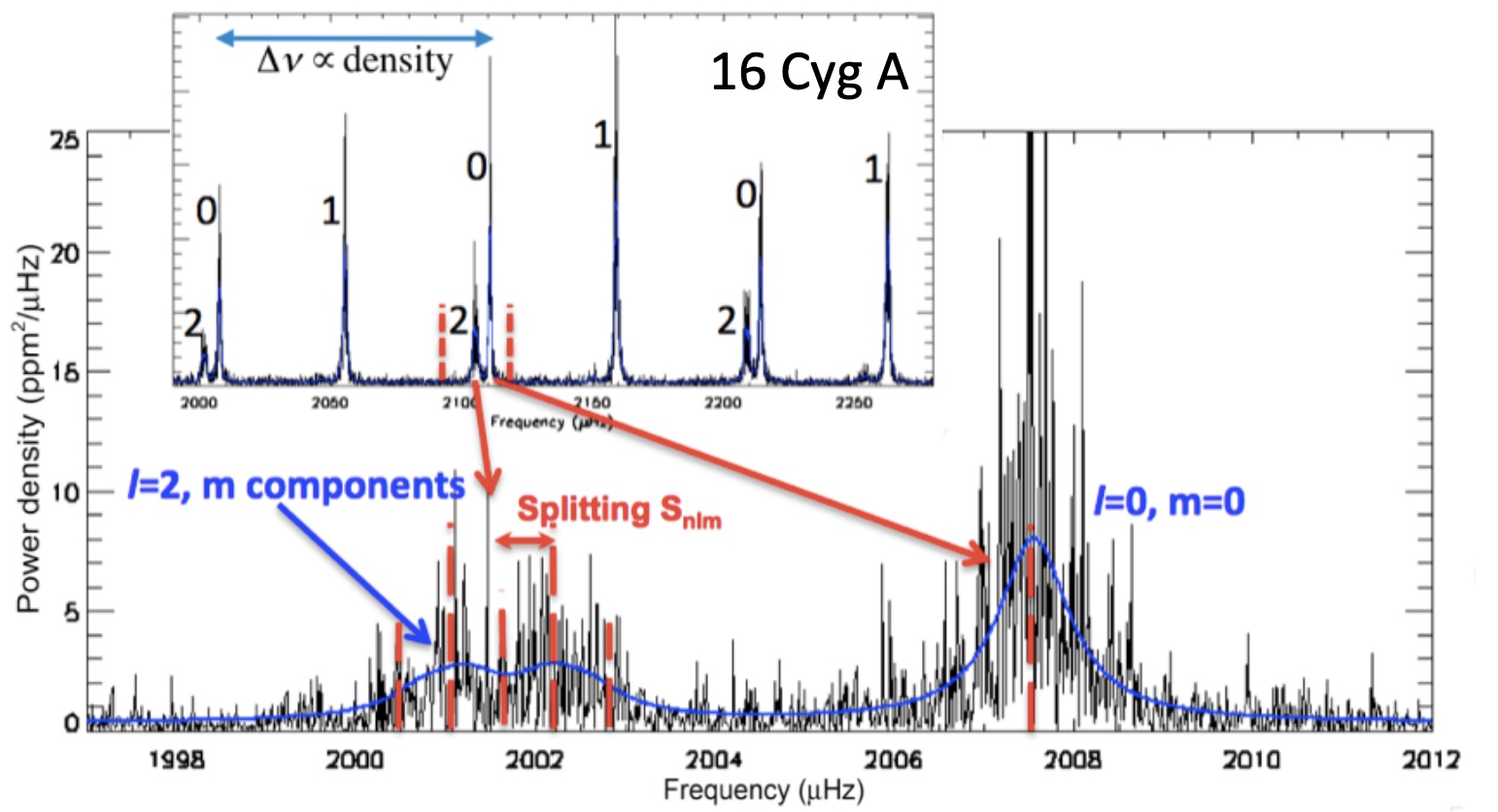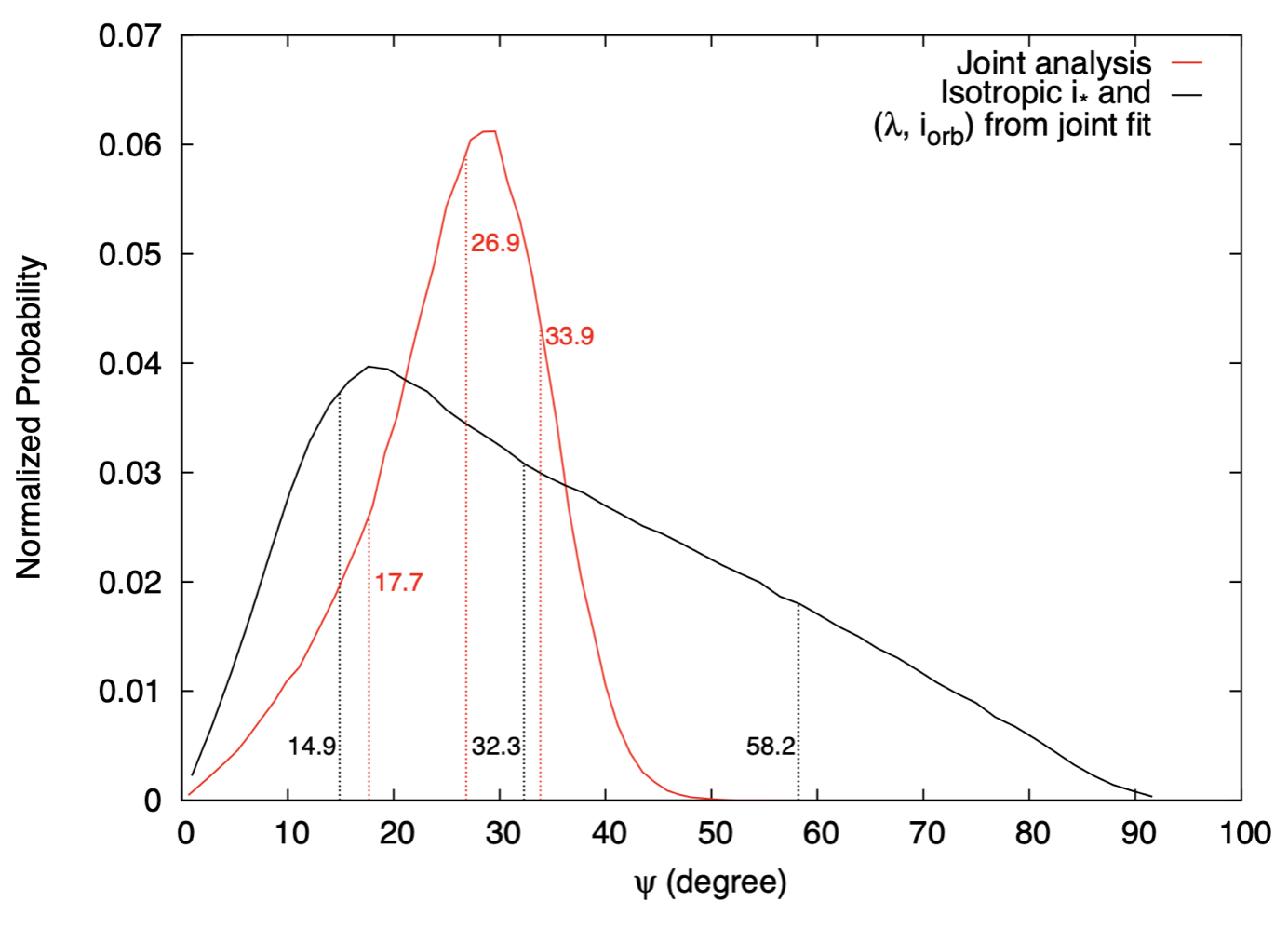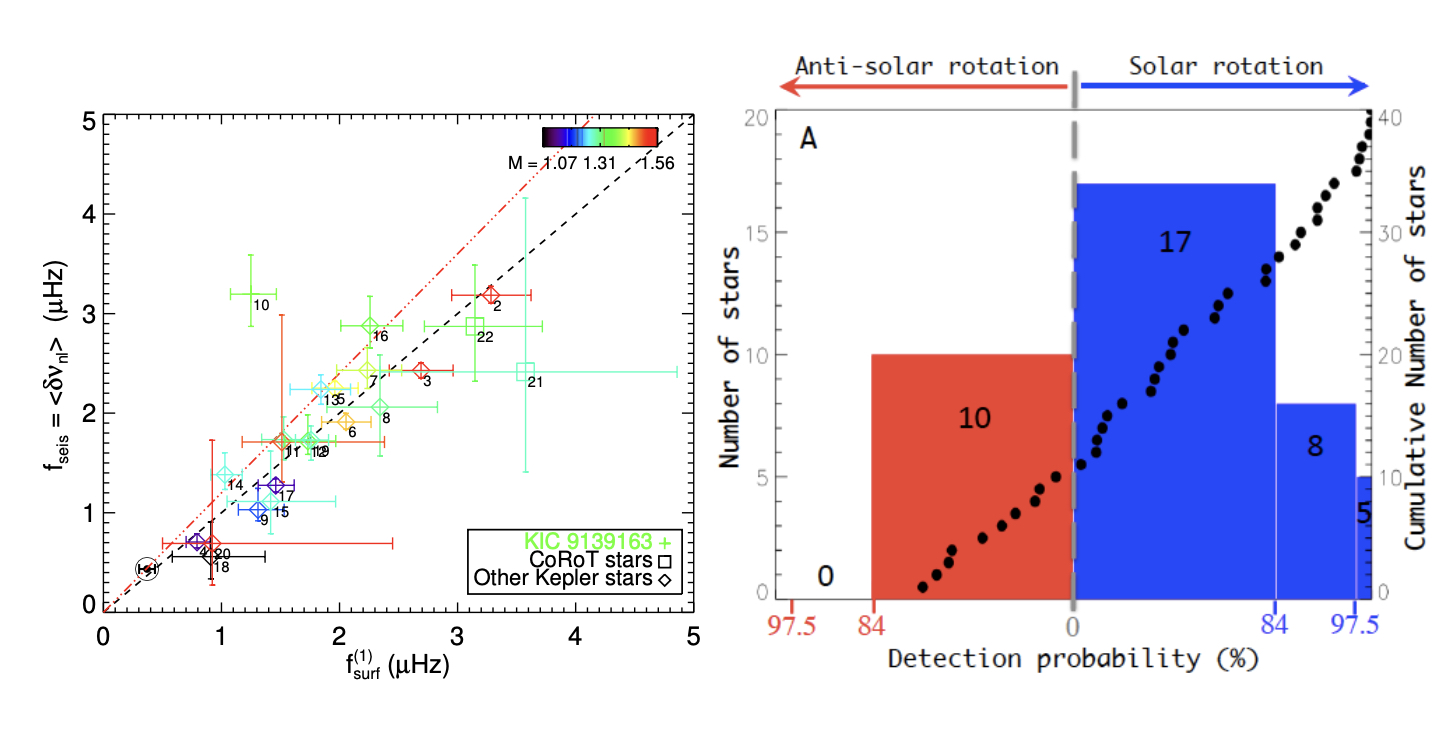a. Context and importance of my research field in astrophysics
Asteroseismology, the study of stellar oscillations, plays a crucial role in our understanding of the universe. By measuring and interpreting the seismic waves within stars, we gain valuable insights into their internal structure and evolution. This knowledge is not only fundamental to comprehend the nature of stars (eg. Benomar et al. 2018), but it also holds significant implications for exoplanet research (eg. Huber et al. 2013), and galactic evolution (eg. Miglio et al. 2013).
In connection to exoplanet study, asteroseismology provides essential information for characterizing these distant worlds. To accurately determine the mass and radius of exoplanets, we rely on precise measurements of their host stars. By analyzing stellar oscillations and using that information jointly with high resolution spectroscopic data, we can derive star’s fundamental properties, such as mass, radius and age, with precision and accuracy down to a few percents (White et al. 2013, Gaulme et al. 2016). These levels cannot be achieved with any other method. This, in turn, enables us to refine our understanding of exoplanetary systems and their dynamical evolution. Furthermore, asteroseismology contributes to the investigation of habitable zones within distant planetary systems. The habitable zone is the region around a star where conditions are favorable for the existence of liquid water on a planet's surface. With the very accurate determination of stellar properties, we can better determine the boundaries of these habitable zones (Kasting et al. 1993). Asteroseismology also provides means to determine latitude and intensity (Bazot et al. 2018, Benomar et al. 2023) of active regions, aiding in the search for potentially life-sustaining exoplanets.
Asteroseismology also plays a role in galactic archeology, the study of the formation and evolution of galaxies. Stars are the building blocks of galaxies, and their properties directly influence the evolution of these cosmic structures. By analyzing the oscillations of a large number of stars within the Milky Way, we gain insights into its formation history, chemical composition, and overall structure. This information allows us to reconstruct the past events that shaped our galaxy and to understand its current state.
In recent years, the field of asteroseismology has experienced significant progress, thanks to space missions such as CoRoT, Kepler, and TESS and to the ground based SONG network that observes -Cen-A and other nearby stars regularly since a few years. These missions have provided us with an unprecedented amount of data, allowing us to test and refine our theories of stellar structure and evolution on tens of thousands of stars. Looking ahead, the upcoming PLATO instrument (ESA), scheduled for launch in 2026, will further expand our capabilities in this field, by exploring millions of pulsating stars and detect hundred of thousands pulsating stars, many with exoplanets and in various location across the milky way. This mission will pave the way for the Ariel space mission (ESA), which will study the chemistry of exoplanets and scheduled for 2029.
As for my research, I focus on the analysis and modeling of stars exhibiting solar-like pulsations. By leveraging these pulsations, I have been able to improve our understanding of stars hosting exoplanets, providing valuable constraints on their properties. Through my work, I aim to contribute to the advancement of stellar physics, exoplanet research and galactic evolution.
b. Main Past Researches
Early career
My PhD thesis (Benomar 2010) had for goal to devise a method to precisely and accurately measure the properties of the pulsations of Sun-like stars. I developed my own codes of analysis of pulsations (in C++, Python and IDL). They are based on a Bayesian approach coupled with an adaptive Markov Chain Monte-Carlo sampler (MCMC) including a Langevin dynamics (Atchade et al. 2006), which at the time of my thesis was unique in asteroseismology. Previous methods had used the maximum likelihood estimates, shown to be poor estimators in noisy photometric data (Appourchaux et al. 2008). For example, when applied to HD 49933 and HD 181420, the two first stars observed by CoRoT (Benomar, 2008), the maximum-likelihood incorrectly identifies the degree of the pulsation modes while my method gives what is now known to be the correct answer (Benomar et al. 2009a, Benomar et al. 2009b; White et al. 2012). Identifying pulsation modes in solar-like stars is critical because otherwise, estimates of stellar fundamental parameters could be seriously biased. This code was used to analyse pulsations modes (mode identification, frequency, ...) of most of main-sequence stars observed by CoRoT and Kepler in various collaborative research studies.
Evolved stars
During my first postdoctoral fellowship in Sydney with Prof. Tim Bedding, I mostly worked on evolved solar-like stars. CoRoT and Kepler have revealed pulsations on thousands of such stars. Their power spectra show mixed modes, giving stringent constraints on the stellar core properties and on the envelope. This allows to precisely determine stellar fundamental properties, due to mixed modes that enable us to measure stellar ages within few percents of precision. On red giants, the mixed modes identification relies on the asymptotic theory for the mixed modes (Osaki 1975), whose basic properties allow to segregate stars that depleted their core-hydrogen content but did not ignite helium nuclear reactions from those already in the helium-burning phase (Mosser et al. 2014). For subgiants, the asymptotic theory is not accurate (as these stars are not in the asymptotic regime) so that an alternative method has to be used. I have developed such a new method for performing the mixed mode identification (Benomar et al. 2012; Benomar et al. 2013), and for measuring the basic properties of the mixed modes in subgiants. I could verify some of the theoretical hypothesis about the excitation and damping mechanism of the modes in evolved stars, such as the equipartition of energy among the modes (Benomar et al. 2014). More recently and based on the knowledge that I acquired on evolved stars in the past, I worked with Prof. Shravan Hanasoge and supervised his PhD student Siddharth Dhanpal at TIFR (Mumbai, India) to devise a general machine learning technique in order to measure fundamental mixed modes properties for sub-giants and red giants stars (Dhanpal et al. 2023, Dhanpal et al. 2022), opening the path toward a fast and reliable estimate on their evolutionary stage, mass and radius. My contribution to this work consisted of designing and implementing the code that generates artificial power spectrum data, required for the training of the machine learning method. This collaboration still continues and we now study the rotation profiles of the red giants observed by Kepler using the same machine learning approach.
Stellar rotation and angular momentum transport
A large part of my work is also related to rotation studies. The pulsation modes can reveal the rotation of inner stellar layers, through measurement of azimuthal modes. In fact, helioseismology successfully used these modes to derive the internal rotation profile of the Sun (e.g. Thompson et al. 2003). Contrary to the then-prevailing view, it was found that deep layers of Sun rotate uniformly, with a latitudinal differential rotation confined to the convective zone. Now asteroseismology enables us to perform similar analysis, but for thousands of stars. These analyses rely on the fact that stars are nearly spherical and spherical harmonics can be used to describe global pulsations. In addition, the perturbative theory is involved to describe effects of rotation and stellar distortion (e.g centrifugal effects) on pulsation frequencies. In the absence of rotation, all azimuthal modes are degenerated. Similarly to the Zeeman effect, the rotation lift this degeneracy, revealing a fine structure of split modes in the power spectrum of stars. The tiny frequency shifts enable us to infer the radial and latitudinal rotational profile of a star, but also the star’s shape. For solar-like stars, such analyses are difficult and require sophisticated methods.

Fig.1 Power spectrum of 16 Cyg A, observed by Kepler. On the inset, pressure modes are identified by their degrees. A zoom on a radial (l = 0) and quadrupolar (l = 2) mode is shown. Split components (m, vertical red lines) are clearly separated for the l = 2 modes.
Due to the complexity of the measurement, current studies mostly assume the first order perturbation alone and thus a solid-body rotation in main-sequence solar-like stars. However, the centrifugal force deforms the cavity in which the modes propagate (star flattened at the poles), Inducing frequency changes for azimuthal modes (Gizon & Solanki 2004). Taking account of this effect, we were able to determine the degree of asphericity for a relatively slow (100 days) and massive star (spectral type A). The measured difference in radius between the pole and the equator does not exceed a few kilometers (Gizon et al. 2016), which is less than expected if only the centrifugal force acts. In turn, this suggests the presence of a magnetic field and is qualitatively consistent with the Sun. During the maximum of activity, the global solar magnetic field is more intense than during the minimum of activity. This contracts the star at the equator (the Sun then has the form of a rugby ball) and counterbalances the effect of the centrifugal force on the shape of the star. Very recently (Benomar et al. 2023), I studied further the shape of the Sun-like stars 16 Cyg A and B and devised a method to determine the latitudes of active regions from their shape. A similar study is now ongoing for all the other ~170 Kepler main-sequence Sun-like stars with detected pulsations (Benomar et al. 2024, in prep).
In Benomar et al. (2015), I measured the average internal rotation rate and demonstrated that the vast majority of Sun-like stars have a surface rotation which does not differ by more than 50% compared to the internal rotation rate. This indicates the presence of a mechanism of transport of angular momentum between deep layers and the surface for the vast majority of main-sequence Sun-like stars, as it is the case for the Sun. This is also consistent with two other studies on subgiants and giants that I co-authored (Deheuvels et al. 2012 and Deheuvels et al. 2014). This evidence of transport of angular momentum for stars all along the evolution tracks of Sun-like stars points to the (yet unknown) mechanism(s) in play. A currently favored hypothesis is a transport by gravity wave or by magnetic field. I also looked at the differential rotation in solar-like stars (Benomar et al. 2018). This also modifies the frequencies of azimuthal modes (e.g. Schou 1994). I was also able to use this to constrain the latitudinal differential rotation in the convection zones of 40 Sun-like stars observed by Kepler. Using a statistical analysis of the ensemble, I found that all stars for which we clearly detect the latitudinal differential rotation have poles rotating slower than the equator, like the Sun. None of them have an anti-solar rotation. For the most significant detections, the stars’ equators rotate approximately twice as fast as their mid-latitudes, while for the Sun, this does not exceed 15%. This latitudinal shear is much larger than predictions from numerical simulations, suggesting an efficient small scale dynamo while the large scale magnetic field is transported in the deeper layer of the star. A buried magnetic field should provoke a solid-body rotation in the radiative zone, which is consistent with other studies that I have cited above. This is of crucial importance for understanding the link between magnetic activity and the poorly understood underlying mechanisms that generate and sustain differential rotation.
Fig.2 Left. Internal rotation versus surface rotation (symbols) compared with a model without angular momentum transport (red line). Stars below the red line require an internal mechanism of transport of angular momentum. Right. Probability of solar-like rotation versus anti-solar rotation. The 13 stars with clear detection have solar-like rotation.
Exoplanet studies
Asteroseismology provide a unique method for us to determine the angle between the orbital plane of a transiting planet and the stellar axis of rotation. This angle, referred as the obliquity, is a unique means for constraining the mechanisms of genesis and of evolution of planetary systems. For example, Jupiter-size planets with orbital periods of a few weeks are likely to have migrated inward because they can not form very close to a star. According to current models, a disk-planet interaction produces planets on an orbital plane perpendicular to the stellar rotation axis (in the Sun's case, near zero obliquity) whereas a planet-planet interaction (with the Kozai mechanism) predicts oblique orbits. In this example, the precise determination of the obliquity and its statistical distribution must provide strong constraints on the contribution of these different scenarios.

Fig.3 Probability distributions for the 3D obliquity of Kepler-25c. The red lines are our measurement.The black one is the with no information on the stellar inclination.
The measurement of the obliquity is difficult since three angles must be known. (a) the orbital inclination angle of a transiting planet, derived from the transit curves with an accuracy of a few percent. (b) The projected obliquity on the sky plane, most commonly measured using the Rossiter-McLaughlin effect. (c) the stellar inclination, directly measurable by asteroseismology (Gizon&Solanki 2004).
Most existing studies of obliquity rely on the measurement of the two angle (a) and (b) to derive their conclusion, that render the interpretation of the projected obliquity difficult (Albrecht et al., 2013). For example with one of my PhD student, we were able to determine that Kepler-408 has an oblique earth-size planet (Kamiaka et al. 2019). Furthermore, in the Kepler field, there are two exoplanet systems for which a true 3D obliquity can be directly measured: Kepler 25 and HAT-P-7. For the first time, I have provided evidence that Kepler-25 (Benomar et al. 2014, Campante et al. 2016) planets are co-planar and roughly aligned, as expected for multiple planet systems (as it is the case for the Sun). While for HAT-P-7, host of a hot-Jupiter, the 3D spin orbit angle confirms that the planet is in a polar or retrograde orbit, suggesting complex birth and evolution. While Kepler could not provide large statistical data on the obliquity, the PLATO mission, specifically designed to cover a large section of the sky and to foster synergy between exoplanet and asteroseismology, is expected to provide the 3D obliquity for sufficient number of systems to allow unbiased statistical studies (PLATO Team, 2017).
References
Kasting, J.F., Whitmire, D.P., Reynolds, R.T., Jan, 1993, Icarus, 101,1
Schou J, 1994, ApJ, 434, 378
Thompson M.J, Christensen-Dalsgaard J., Miesch M.S., Toomre, J., 2003, AR&AA, 41, 599-643
Gizon & Solanki 2004,ApJ, 589, 2
Atchadé Y. F. 2006, Meth. Comp. In Applied Probab., 8, 235
Appourchaux T., Michel E., Auvergne M., et al. 2008, A&A, 488, 705
Benomar O. 2008 https://www.theses.fr/2010PA112309, https://othmanbenomar.dev/files/These_v1.2.1.pdf
Benomar O. 2008, Communiations in Asteroseismology, 157, 98
Benomar O., Appourchaux T., & Baudin F. 2009a, A&A, 506, 15
Benomar O., Baudin F., Campante T. L., et al. 2009b, A&A, 507, L13
White T. R., Bedding T. R., Gruberbauer M., Benomar O., et al., 2012, ApJL, 751, L36
Benomar O., Bedding T. R., Stello D., Deheuvels et al. 2012, ApJL, 745, L33
Deheuvels S., García R. A., Chaplin W. J., Basu S. et al. ,2012, ApJ, 756, 19
Miglio A. Chiappini C., Morel T., Barbieri M., et al., 2013b, MNRAS, 429, 423
Albrecht S, Winn J.N., Marcy G.W. et al. 2013, ApJ, 771, 1
Huber D., Carter J. A. Barbieri M., Miglio A. et al. 2013, Science, 342, 6156
Benomar O., Bedding T. R., Mosser B., Stello D., et al. 2013, ApJ, 767, 158
White T.R., Huber D., Maestro V. , Bedding T.R., et al. 2013, MNRAS, 433,2
Mosser B., Benomar O., Belkacem K., Goupil M. J., et al. 2014, A&A, 572, L5
Benomar O., Belkacem K., Bedding T. R., Stello D., et al. 2014, ApJL, 781, L29
Deheuvels S., Doğan G., Goupil M. J., Appourchaux T., Benomar O., et al. 2014, A&A, 564, A27
Benomar O., Takata M., Shibahashi, H. Ceillier T., & García R. A., 2015, MNRAS, 452, 2654
Gizon L., Sekii T., Takata M., Kurtz D., et al. 2016, Science Advances, 2, e1601777
Gaulme P., McKeever J., Jackiewicz J., Rawls M.L. et al. 2016, ApJ, 832, 2
Campante T.L., Lund M.N., Kuszlewicz J.S., Davies, G.R., et al. 2016, ApJ. 819, 85
Plato Team, 2017, ESA-SCI(2017)1, https://platomission.com/2018/03/08/esa-publications/
Benomar O., Bazot M., Nielsen M. B., Gizon L., 2018, Science, 361, 1231
Bazot M., Nielsen M. B., Mary D., Christensen-Dalsgaard J., 2018, A&A, 619, L9
Kamiaka, S., Benomar, O., Suto, Y., Dai, F. et al., 2019, AJ, 157, 137.
Dhanpal S., Benomar O., Hanasoge S., Kundu A., et al. 2022, ApJ, 928, 188
Lu Y., Benomar O., Kamiaka S., Suto Y., 2022, ApJ, 941, 75
Dhanpal S., Benomar O., Hanasoge S., Takata M., et al. 2023, Accepted to ApJ
Benomar O., Takata M., Bazot M., Sekii T., Gizon L., Lu Y., 2023, A&A, in Press
